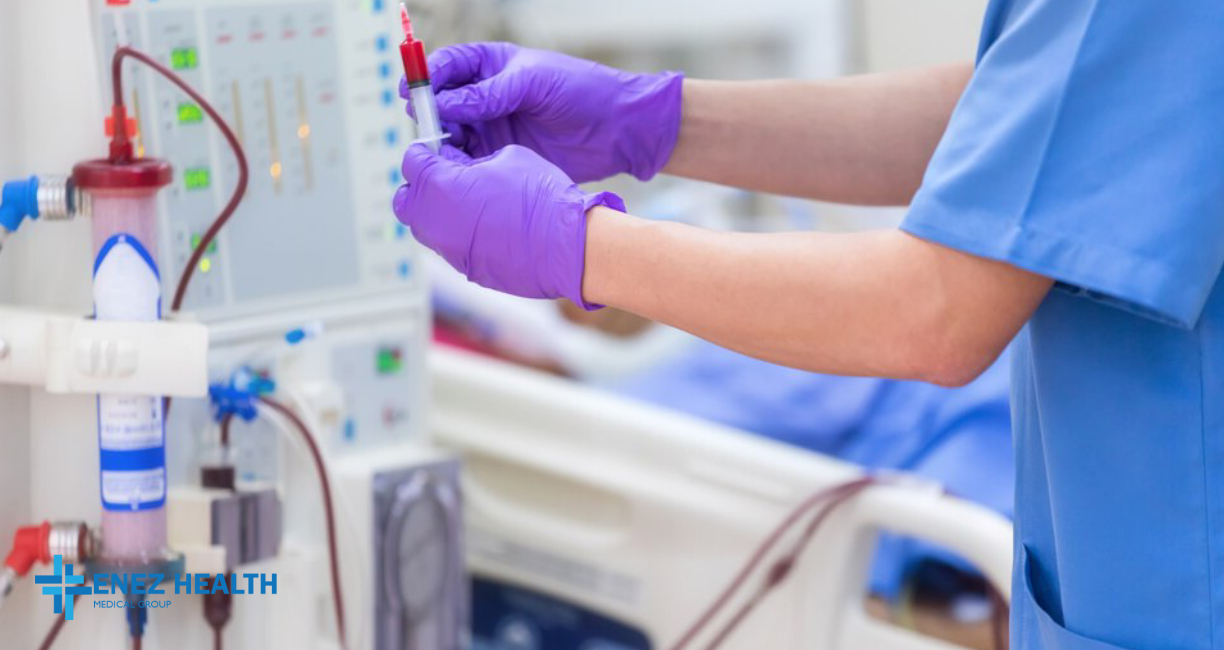
Weighing around 100 to 150 g, kidney is the organ located at posterior part of the abdomen. It measures 9 to 12 cm in length, 4 to 5 cm in width and 3 to 5 cm in thickness. Healthy people have two kidneys, one at right side and one at left side.
Approximately one in a thousand people are born with only one kidney. Having one kidney poses no significant health risk. Functions of our kidneys are as follows:
- To regulate water and salt balance in our body.
- To clean blood by excreting waste substances (urea and creatinine) that are produced after protein, one of the nutrients we ingest, is processed in body.
- To check blood production and stimulate bone marrow to increase blood production in case of anemia.
- To make Vitamin D, which is required for bone development, bioavailable after it interacts with sunlight.
- To break down certain hormones produced in our body (such as insulin).
WHAT IS HEMODIALYSIS?
In the simplest terms, dialysis is a two-chamber system with a semipermeable membrane between two chambers; venous blood is contained in one chamber, while the other chamber is filled in with dialysis fluid (dialysate). Hemodialysis is a process where the blood is pumped outside of the body and run by a machine through an artificial filter (dialyzer) to remove toxic material and excess fluid from your blood and next, your blood is pumped back to your body. Certain types of salts that are deficient in the body are instilled from the dialysis fluid to the body. For hemodialysis, an artery of your arm is surgically connected (fistulized) to a vein of your arm. Hemodialysis treatment can be started three to four weeks after an arteriovenous fistula is created. If the patient who needs dialysis urgently has no or underdeveloped fistula, a catheter can be inserted into a vein in neck or groin to do hemodialysis. An arteriovenous fistula should be created several months before the estimated start date of dialysis in order to enable sufficient development of the fistula and avoid the need of catheter.
HEMODIALYSIS PROCEDURES?
Hemodialysis is done twice or 3 times per week in hemodialysis centers and each treatment session lasts approximately 4 hours. In each hemodialysis session, two needles are inserted into the arteriovenous fistula, including one that transfers venous blood to the filter in order to have your blood cleaned and the other one that flows the clean blood into your body. Blood thinner or anti-coagulant agents should be administered to prevent clotting of the blood outside of the body during the treatment. Number of weekly sessions, duration of each session, the type of filter to be used in dialysis and contents of dialysis fluid are decided by the treatment team depending on patient’s medical condition.
Our hemodialysis unit aims to obtain exemplary results in Turkey by advancing beyond EU standards on hemodialysis. Data deriving from patients, who are currently maintained on this treatment at our units, are above the criteria set by Kidney Disease Outcomes Quality Initiative (KDOQI) that aims better life conditions for dialysis patients, and our data is also far above average values recorded in Turkey.
All patients are provided with broadcasting system to help them watch satellite broadcasts on an LCD television, transportation services between home and hospital, consultation system to manage potential health problems that are not related with dialysis, psychological counseling and guidance services by a psychiatrist as well as dietician service for personalized diet for each patient.
Tags: Hemodialysis, Hemodialysis Department, Hemodialysis Center, Hemodialysis Doctors, Hemodialysis in Istanbul, Hemodialysis in Turkey
- Aeromedical Center
- Aesthetic, Plastic & Reconstructive Surgery
- Algology
- Allergy Immunology
- Anesthesiology and Reanimation
- Biochemistry and Molecular Biology
- Cardiology
- Cardiovascular Surgery
- Check up
- Chest Diseases
- Chest Surgery (Thoracic Surgery)
- Dermatology
- Ear, Nose & Throat
- Emergency Service
- Endocrine and Metabolic Disorders
- Endocrinology, Diabetes and Metabolic Diseases
- Eye Health & Diseases
- Gastroenterological Diseases and Surgery
- Gastroenterology
- General Surgery
- Genetic Disease Diagnostic Center
- Hair Transplant Center
- Hand and Microsurgery
- Hematology
- Hemodialysis
- In Vitro Fertilization (IVF)
- Infectious Diseases and Clinical Microbiology
- Intensive Care
- Internal Diseases
- Interventional Radiology
- Laboratory Services
- Medical Oncology
- Microbiology
- Neonatal Intensive Care Unit
- Nephrology
- Neurology
- Neurosurgery
- Nuclear Medicine
- Nutrition and Diet
- Obesity Surgery
- Obstetrics and Gynecology
- Oral And Dental Health
- Organ Transplantation Centers
- Orthodontics
- Orthopedics and Traumatology
- Pathology
- Pediatric Allergy and Immunology
- Pediatric Cardiology
- Pediatric Endocrinology
- Pediatric Gastroenterology, Hepatology & Nutrition
- Pediatric Health and Diseases
- Pediatric Hematology
- Pediatric Intensive Care
- Pediatric Nephrology
- Pediatric Neurology
- Pediatric Oncology
- Pediatric Surgery
- Pediatric Urology
- Perinatology
- Physical Therapy and Rehabilitation
- Podology
- Psychiatry
- Psychology
- Radiation Oncology
- Radiology
- Rheumatology
- Stroke Center
- Urology

